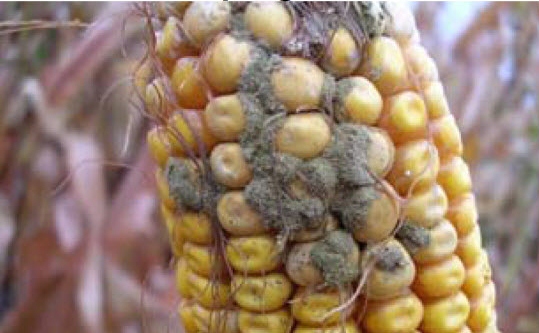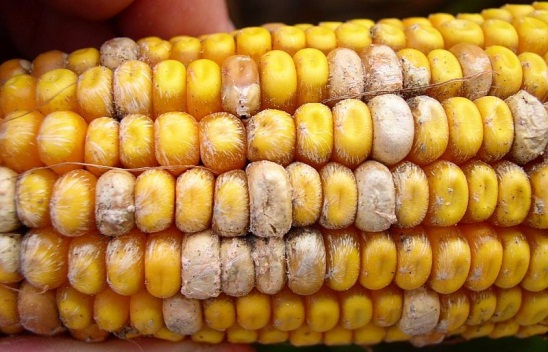Mycotoxin in Corn
go.ncsu.edu/readext?316647
en Español / em Português
El inglés es el idioma de control de esta página. En la medida en que haya algún conflicto entre la traducción al inglés y la traducción, el inglés prevalece.
Al hacer clic en el enlace de traducción se activa un servicio de traducción gratuito para convertir la página al español. Al igual que con cualquier traducción por Internet, la conversión no es sensible al contexto y puede que no traduzca el texto en su significado original. NC State Extension no garantiza la exactitud del texto traducido. Por favor, tenga en cuenta que algunas aplicaciones y/o servicios pueden no funcionar como se espera cuando se traducen.
Português
Inglês é o idioma de controle desta página. Na medida que haja algum conflito entre o texto original em Inglês e a tradução, o Inglês prevalece.
Ao clicar no link de tradução, um serviço gratuito de tradução será ativado para converter a página para o Português. Como em qualquer tradução pela internet, a conversão não é sensivel ao contexto e pode não ocorrer a tradução para o significado orginal. O serviço de Extensão da Carolina do Norte (NC State Extension) não garante a exatidão do texto traduzido. Por favor, observe que algumas funções ou serviços podem não funcionar como esperado após a tradução.
English
English is the controlling language of this page. To the extent there is any conflict between the English text and the translation, English controls.
Clicking on the translation link activates a free translation service to convert the page to Spanish. As with any Internet translation, the conversion is not context-sensitive and may not translate the text to its original meaning. NC State Extension does not guarantee the accuracy of the translated text. Please note that some applications and/or services may not function as expected when translated.
Collapse ▲Mycotoxin in corn continues to be an issue for NC corn producers and NC Extension Corn Specialist Ron Heiniger says they need to be addressed. At a recent field day Heiniger said “There are no good mycotoxins. We want it gone, stomped out, eliminated. It’s just like a weed in a a field. There is no good weed, and the same is true about mycotoxins.”
One of the most concerning mycotoxins in NC is aflatoxin which is caused by ear rot fungi. Aflatoxin is harmful to livestock and humans, and by law corn with high mycotoxin levels cannot be sold.
Fungal infections of the ear occur during pollination. Drought stress results in a lack of synchronization between pollen shed by the tassel and the emergence of the silks from the ear. This increases the chance that pollen will not be viable when it reaches the silk tube. Often the silk tube is longer and less resistant to fungal spores. In addition, kernel sites where pollination has to failed to occur have ideal conditions for harboring and incubating fungal pathogens.
Heiniger says infection through the silk tube is the most common infection that occurs in NC, and causes the biggest problems for farmers. “While the infection occurs during pollination, the key to ear rot damage lies in ideal conditions for growth of the fungal pathogen during the period from corn pollination to physiological maturity,” Heiniger said. “Frequent rainfall events provide the ideal climate of moisture and high humidity needed for fungal growth and reproduction.”
Heiniger said drought damage leads to lack of good shuck coverage which allows rainfall to penetrate the shuck and holds the moisture next to developing kernels. “Once the corn reaches physiological maturity, the kernel is sealed off by the black layer and fungal infections become worse, leading to the production of mycotoxins.”
Prevention of mycotoxin formation is essential since there are few ways to completely overcome problems once mycotoxins are present. Drought and insect damage are most important in instigating molding and mycotoxin formation in the field. Choosing varieties that have some resistance to fungal disease and resistance to insect damage, like Bt hybrids, can reduce field-produced mycotoxins. Irrigation can reduce mycotoxin formation in the field. When harvesting avoid lodged or fallen material, because contact with the soil can increase mycotoxins. Mycotoxins increase with delayed harvest and with late season rain and cool periods.
Growers should scout fields and look for the presence of a gray-green mold in the kernels at the tip or base of the ear or for the presence of a white mold or white starburst pattern in the kernels at the tip of the ear. The presence of either of these symptoms indicates that Aspergillus Flavus or Fusarium moniliform has developed in the field. However this does not necessarily mean that mycotoxins are present. Growers should send a sample to be analyzed for myctoxins. If the test shows there are no mycotoxins found then growers should plan to harvest early to prevent further infection.






